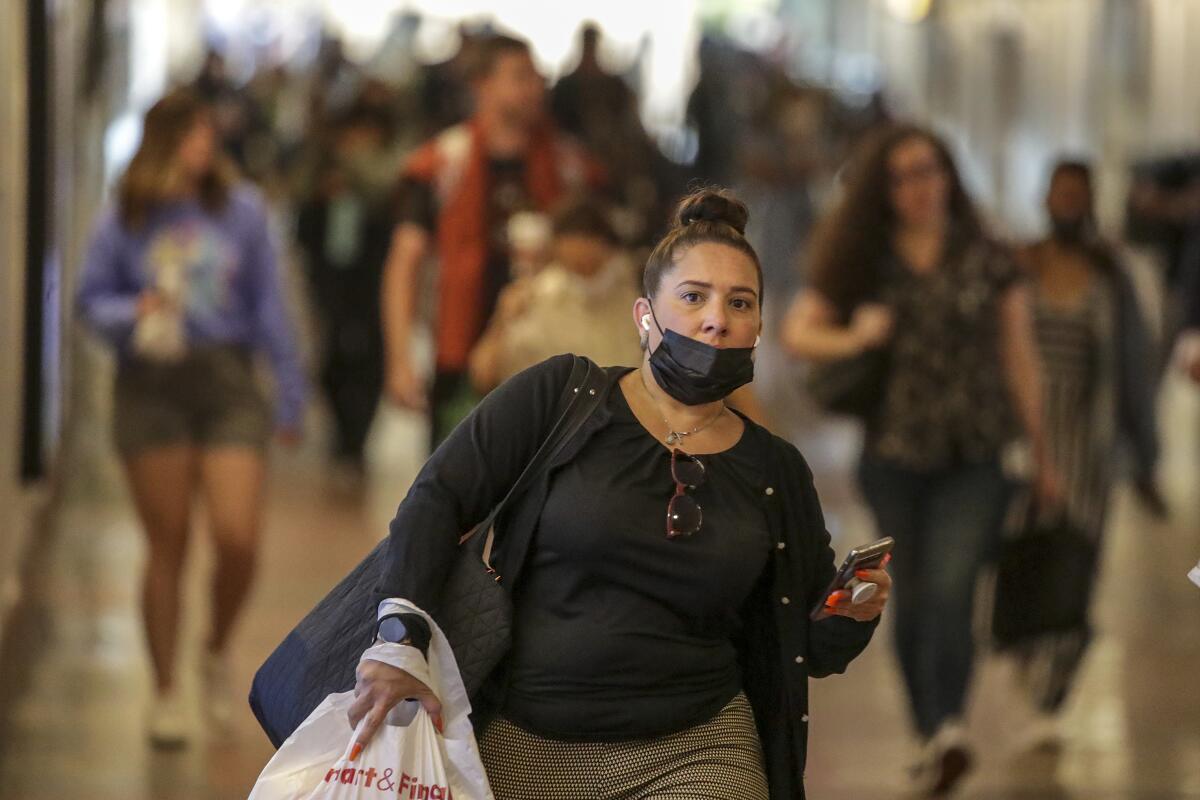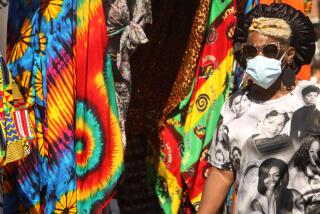Coronavirus cases start to flatten in L.A. County as decision on mask mandate looms

Weekly coronavirus cases are showing early signs of flattening in Los Angeles County, but they remain at significantly elevated levels as a decision on whether to impose a new indoor mask mandate looms on Thursday.
It’s too soon to say whether it’s a blip or the beginning of a sustained trend. Since cases began increasing in late March, there have been three times where they began to drop, only to be followed by steeper increases later, with transmission worsened by increasingly ultracontagious variants capable of reinfecting people within several weeks.
But the recent flattening in cases was something that L.A. County Public Health Director Barbara Ferrer also noted publicly recently. Should a flattening in cases be followed by a steep decrease in the coming days — something that cannot be predicted with certainty — it is possible that Ferrer could postpone a universal mask mandate that was set to be enacted on Friday if conditions do not improve by then.
“You can see here this sign of plateauing cases of the past week, and we do hope this continues,” Ferrer said at a press briefing Thursday. “I do want to note, however, that over the past two months, we have seen some small dips that were then followed by additional increases, so it does make sense for us to continue to be cautious, given the relatively high number of cases we see.”
The latest numbers do not show a steep decline in cases. But, Ferrer said Thursday, “should we start seeing a steep decline in our numbers next week … we are likely to want to take a pause on moving too quickly on a universal indoor masking [order]. Because if our cases really start a steep decline, it’s likely that a couple of weeks from now, our hospitalizations will also decline.”
As of Friday evening, L.A. County was averaging about 6,600 new coronavirus cases a day over the past week, a 2% week-over-week decline. On a per capita basis, that’s 460 new cases a week for every 100,000 residents; a rate of 100 or more is considered high.
The trigger that has placed L.A. County on track for a universal mask mandate was its rate of new coronavirus-positive hospitalizations rising above a certain threshold, signifying that the county was in a “high” COVID-19 community level, as defined by U.S. Centers for Disease Control and Prevention.
That threshold is 10 or more new coronavirus-positive hospital admissions a week for every 100,000 residents. L.A. County’s rate on July 14 was 10.5, and on Thursday it was 11.4.
But Ferrer added that new coronavirus-positive hospitalizations “may also be leveling off a bit.”
Data released Saturday added to the possibility that the increase in hospitalizations may be slowing, although it will take more days of data to be sure. On Friday, there were 1,200 coronavirus-positive patients in hospitals in L.A. County, a 4% decrease from the previous Friday, when the patient census was 1,252.
L.A. County recorded 1,329 coronavirus-positive hospitalizations on Wednesday. Since then, the tally has fallen by almost 10%.
A sustained reduction in coronavirus cases in the coming days — if it happens — would eventually push L.A. County back into the “medium” COVID-19 community level, Ferrer said.
“You can see we’re on the cusp, between medium and high. It isn’t going to take much to move us back into that medium community level if we can get our case numbers to go lower,” Ferrer said.
Weekly COVID-19 deaths in L.A. County remain elevated. As of Friday, L.A. County was recording about 100 deaths a week; a month ago, it was recording about 50 deaths a week.
COVID-19 deaths in California have also begun to rise. In June, California was averaging about 200 deaths a week; in July so far, the state has been averaging about 260 deaths a week.
Hospitalizations statewide are also growing at a more modest pace over the past week. On Friday, there were 4,626 coronavirus-positive patients in California, up 3% from the previous week. The prior week-over-week increase was almost 12%.
Hospitalizations have dropped in the last couple of days statewide. On Tuesday, coronavirus-positive hospitalizations hit a summer high of 4,790, and by Friday had dropped by about 3%.
The number of coronavirus-positive intensive care patients statewide has also flattened. There were 515 on Friday, up about 2% from a week earlier.
Of the state’s 25 most populous counties, L.A. County now has the highest coronavirus case rate, followed by San Diego, Fresno, San Bernardino and Riverside counties. The San Francisco Bay Area once had the state’s highest case rate earlier in this surge, but now ranks lower than Southern California as a region.
A renewed indoor mask mandate for L.A. County would apply for anyone age 2 or older at a host of establishments and venues, including shared office space, manufacturing and retail settings, event spaces, restaurants and bars, gyms and yoga studios, educational settings and children’s programs.
The order would be lifted when the county exits the high COVID-19 community level and stays out of that category for two consecutive weeks. Ferrer, however, has also raised the possibility of a quicker exit from a masking order, depending on the situation.
Some critics question the need for a mask mandate. Hospitals and intensive care units are nowhere near as strained as during the peaks of previous surges and, thanks in part to vaccinations and anti-COVID drugs, the relative overall risk of severe illness is far less than it was a year or two ago.
Some business groups have voiced concerns that a mask order could prompt shoppers to take their money elsewhere, or that workers will have to enforce rules many no longer want to follow.
Should the mandate go into effect, Ferrer said her department will remind businesses that they’re obligated to offer employees masks and put up signs announcing the mask-wearing requirement, so customers and visitors will know a masking requirement is in effect indoors.
She said the county will not ask businesses “to be enforcers” of the mandate and said, “we understand, as there has been throughout the pandemic, that there are some people who will go ahead and … not be in compliance.”
But she said she hopes most people will wear masks at businesses that have good signage.
Ferrer agrees that the risk of COVID-19 is less than it once was, and said, “We’re in a much better place.” But she said Thursday there have been troubling signs emerging and suggested the need for a mask order by the end of the month if cases did not dramatically fall in the coming days.
The percentage of emergency room visits related to COVID-19 in the county has doubled since Memorial Day, from 5% to 10%. Worksites have been seeing major disruptions, and some are short on staffing. L.A. County reported 429 worksites with clusters of coronavirus cases in the last week, more than double from the start of June. There were 33 nursing homes with newly reported outbreaks, a figure that has doubled over the same period.
Hospitalization rates have grown much faster in recent weeks for older residents.
“When people pass along misinformation that the current COVID surge is not affecting or hurting anyone, these are the people they are dismissing: our elders,” Ferrer said.
It’s also important to reduce the number of people who could otherwise develop long COVID, she said, in which symptoms of fatigue, brain fog and difficulty breathing can persist for months or years and can be so debilitating that people can no longer work.
Reinfections also add risk: Ferrer cited one study of mostly white veterans, who were on average in their early 60s — who were infected with the coronavirus more than once — had a two times higher risk of death and 2½ times higher risk of developing heart or lung disease or problems with blood vessels and blood clotting, compared to those who were infected once.
And a high level of coronavirus transmission only increases the risk of new mutations that could cause more harm.
“High community transmission also leads to preventable and avoidable deaths, primarily among those most vulnerable,” Ferrer said. “If we can slow down transmission, we have a good chance of preventing some people from dying in the upcoming months.”
More to Read
Sign up for Essential California
The most important California stories and recommendations in your inbox every morning.
You may occasionally receive promotional content from the Los Angeles Times.












